Season 2 - Equipment Roundup
Well it’s been a great sailing season! We have never been so far north! We sailed almost 4 thousand miles and had a chance to fine-tune the new boat! Here is a round-up of new gear that stood out from this season of sailing!
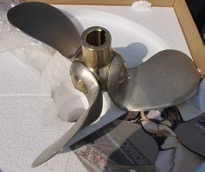 Feathering Prop - Autoprop - Last year I lamented the lack of a feathering or folding prop since I felt we lost too much speed with the big fixed 3-blade prop. So this year we changed to an Autoprop. What a difference! Getting rid of a fixed prop has to be the first thing to do to improve performance. It’s like towing around a bucket. Dollar for dollar it must be the best way to get more speed. The Autoprop automatically adjusts its pitch depending on speed through the water and seems to work quite well.
Feathering Prop - Autoprop - Last year I lamented the lack of a feathering or folding prop since I felt we lost too much speed with the big fixed 3-blade prop. So this year we changed to an Autoprop. What a difference! Getting rid of a fixed prop has to be the first thing to do to improve performance. It’s like towing around a bucket. Dollar for dollar it must be the best way to get more speed. The Autoprop automatically adjusts its pitch depending on speed through the water and seems to work quite well.
Downwind Pole - Selden Carbon Pole - We have always had a downwind pole and use it to pole out one of the headsails when sailing right downwind. We hadn’t got around to installing it when the boat was new so we added it this spring. It’s a carbon pole and even though it is quite large it is easy to lift with one hand! We used it 6-7 times this summer. Mostly it was in quite light air when we might otherwise have had to motor. Nice to have it back!
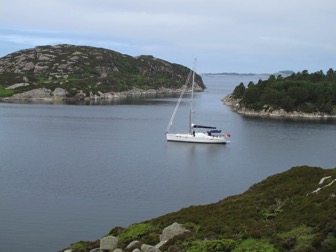 Anchor tackle - Rocna 33KG + 80 meters chain - Norway this summer meant some very deep anchorages. We anchored in 12-18 meters of water a few times. Yikes! It was great having long chain and knowing we would be fine. And as usual the Rocna set beautifully. It is a great all around anchor.
Anchor tackle - Rocna 33KG + 80 meters chain - Norway this summer meant some very deep anchorages. We anchored in 12-18 meters of water a few times. Yikes! It was great having long chain and knowing we would be fine. And as usual the Rocna set beautifully. It is a great all around anchor.
Autopilot Remote - Raymarine Smart Remote - This is a little wireless remote to control the autopilot. It also includes a repeater for all the basic data (speed, depth, wind, heading, VMG etc). On cold or rainy days it is nice to stand up under the dodger (sprayhood) and steer with the remote. Sheryl can take it up to the bow when we are anchoring and check the depth before she drops the hook.
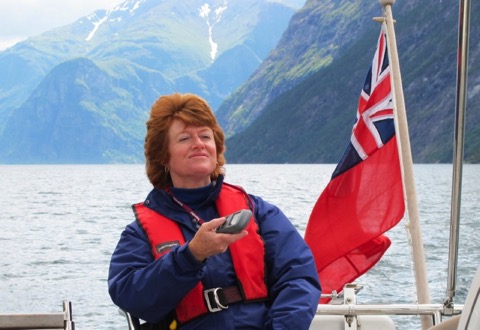
Electronic Charts - Navionics Charts + Apps - Electronic charting has come a long way in a few years. The newest charts are amazingly accurate, and now include lots of other data. Aerial photos of harbours we are approaching are a very nice addition. All tide data is also included so when we sailed in the Brittany coast and the tide exceeded 8 meters we could quickly find a tide station to check where we stood. Much quicker and easier than using printed tide table. Plus I have to recommend the Navionics App!! We have this on our iPhone and it’s amazing. All chart data, plus tides for the British Isles is included in an app for around $20!! How could you NOT buy this. It works for iPhone and there is a HiRes version for iPad. It also comes for Android devices. It’s great for planning (and even serves as a back-up for our chartplotter.)

Downwind Pole - Selden Carbon Pole - We have always had a downwind pole and use it to pole out one of the headsails when sailing right downwind. We hadn’t got around to installing it when the boat was new so we added it this spring. It’s a carbon pole and even though it is quite large it is easy to lift with one hand! We used it 6-7 times this summer. Mostly it was in quite light air when we might otherwise have had to motor. Nice to have it back!

Autopilot Remote - Raymarine Smart Remote - This is a little wireless remote to control the autopilot. It also includes a repeater for all the basic data (speed, depth, wind, heading, VMG etc). On cold or rainy days it is nice to stand up under the dodger (sprayhood) and steer with the remote. Sheryl can take it up to the bow when we are anchoring and check the depth before she drops the hook.

Electronic Charts - Navionics Charts + Apps - Electronic charting has come a long way in a few years. The newest charts are amazingly accurate, and now include lots of other data. Aerial photos of harbours we are approaching are a very nice addition. All tide data is also included so when we sailed in the Brittany coast and the tide exceeded 8 meters we could quickly find a tide station to check where we stood. Much quicker and easier than using printed tide table. Plus I have to recommend the Navionics App!! We have this on our iPhone and it’s amazing. All chart data, plus tides for the British Isles is included in an app for around $20!! How could you NOT buy this. It works for iPhone and there is a HiRes version for iPad. It also comes for Android devices. It’s great for planning (and even serves as a back-up for our chartplotter.)
Comments
Fogbound! Crossing the Channel
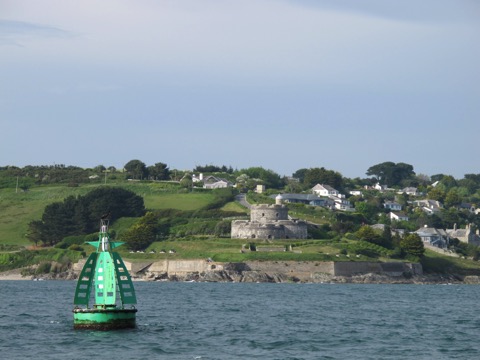
The passage began with a beautiful afternoon departure. Passing the castle guarding the entrance to Falmouth harbour we pointed the bows towards France. There was a light southerly breeze and a forecast for a quiet night.

The channel crossing is around 100 miles from Falmouth to the Rade de Brest and we needed to reach the strong tides of the Chenal du Four (at the corner of France near Brest) near dawn when they would be in our favour. This means crossing one of the busiest shipping lanes in the world in the dark. Then the fog rolled in!
I don’t think we have ever seen a thicker fog! We could just see the bow of the boat 40 feet away, but nothing more. Our navigation lights created pools of light in the fog and mist settled on everything. For the next 8 hours we could see nothing past our own decks.
AIS
I have written before about AIS and how much we like having it. WELL!! If ever a device paid its keep it was that night. We could see every ship out there and they could see us as well. We did not have to worry about the shipping lanes.
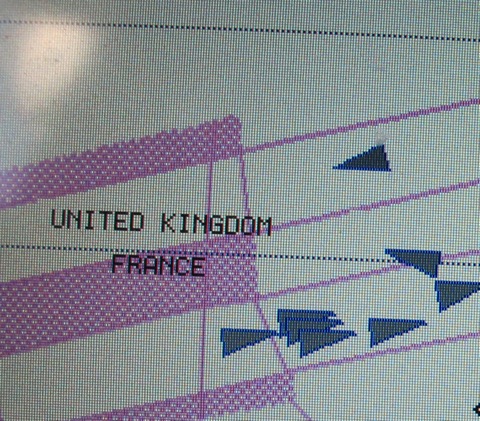
We were crossing before the start of the TSS (Traffic Separation Scheme) which directs shipping around the corner of France so were not obligated to cross at a direct right angle. However our course was at right angles anyway. And when shipping is so nice and organized it is best to cross it quickly and be away from the area as soon as possible.
RADAR
Of course not all boats have an AIS transponder. So our biggest worry in the thick fog is smaller boats such as fishing boats and other yachts. As we were leaving the coast there was another sailboat in sight and he DID have an AIS. But naturally there might be others. We have used the radar often in broad daylight to check how it works at picking up smaller boats. It is good to practice with the equipment. I find that we usually see a reasonable echo for small sailboats around 3 miles away. Over here in Europe most boats have a radar reflector mounted up on the mast - the most popular by far is the ones that look like a white 6 inch diameter fender. But even when I can’t see a reflector in their rigging, we usually pick up sailboats 3 miles away. Certainly 1-2 miles even small day-boats show up as a nice target. Sheryl is particularly good at reading the radar, noticing a faint target that only appears occasionally will then reappear in the same spot after a couple more rotations of the scanner.
The fog lay like a heavy wool blanket over the sea. There was no moon but during Sheryl’s watch from 2200 to 0100 the fog would occasionally clear above the mast head to reveal a few stars. But still at deck level we were rolling along in a thick air, cut into precise sector slices by our nav lights. We were not yet in the shipping lanes so there were no ships during this watch. Sheryl saw two targets on radar, one crossing our bow at two miles distance. With worrying radar targets, we set a few waypoints on it’s position to mark their track. One of the targets must have been a fishing boat nearly stationary as the waypoints showed it almost still.
There were also a number of larger fishing boats, thankfully all running AIS. In one case, I was just altering course to avoid it when it turned directly towards us just 2 miles away.
"Distant Shores Distant Shores, This is fishing vessel Eruva. We are fishing and are just about to alter course and I will be travelling at 045 degrees. Could you give me four cables searoom astern."
"Eruva, Distant Shores, roger we will alter course to pass your stern by half a mile"
What a great recommendation for the AIS technology. In fog we both could see each other clearly, and he knew our boat name to give us a call.
The fog cleared by dawn and we arrived in France at Camaret!
AIS Transponders by Raymarine
Budget for Cruising
20/07/11 04:24 Filed in: Budget | Life Aboard

Monthly Expenses - This is the first question most people ask when trying to plan a long term cruise. What might it cost per month? The answer, as one might expect, varies dramatically! Cruising Style and Type of Boat are two factors... and then add in other more occasional expenses below.

Cruising Style
- Beans and Rice cruising used to be more popular - minimal food, no marina stays, no car rentals, maintaining the boat yourself without all the options - it was possible to cruise for $500-800 - perhaps thats risen a little recently so figure $800-1000. But not many people are doing that anymore in our experience.
- Budget Cruising - Anchor most of the time, occasional marina visits, a few frills and the occasional meal ashore - $1000-1500 depending on boat size. This is easier in the Caribbean or someplace where you want to anchor all the time anyway. Groceries and boat repairs take much of the budget but you eat better than Beans and Rice ;-)
- Comfortable Cruising - $1500-2500 - Rent a car occasionally, stay in marinas more often and eat ashore to get the flavour of the area you are cruising.
- Sky’s the limit - There is no limit to what you COULD spend - fly home occasionally - eat out "like a power-boater" ;-) it is possible to spend well over $5000 a month
- On the Move - If you are planning a fast round trip cruise it will cost more than a relaxed winter in the Bahamas. Doing an Atlantic Circle trip in 1-2 years will mean more things break and you are in unfamiliar territory more often. Similarly a quick trip down the intracoastal means you spend more than a relaxed trip when you find the more affordable options up the side creeks. Add $500/month if you are in a hurry.
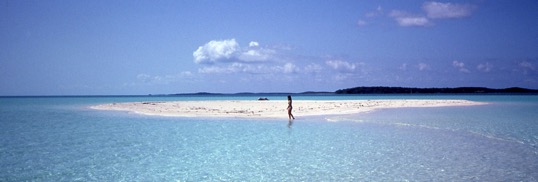
Type of Boat
- Pocket/Small Cruiser - 25-32 foot - We don’t see many cruisers less than 32 feet on extended cruising these days. But if they are they can be doing it for less money. But it is not a good idea to try to cram all the available upgrades on a small boat. We have seen 30 footers with davits, air-con, large dinghy and outboards and stern arches. A small boat can be seriously overloaded and might be dangerous at sea. But a small sailboat is the least expensive option and can be a very seaworthy and fun way to get out cruising. Less time/money spent on maintenance if you keep it simple!
- Mid-size Cruiser - 35-42 - most popular size cruiser. By the time you get to 42 feet the budget for fuel and maintenance is getting higher but the boat is well able to handle a couple in relative comfort. There is room to store what you need and most 42 footers can handle a dinghy on a stern arch, upgraded battery capacity etc. Add $300-400/month for DIY maintenance - more to have someone do the work for you.
- Larger Cruiser - 44-54 foot - this is the limit for most cruisers we see out there. Budget for dockage, fuel and maintenance is naturally higher than the smaller boats. In the Caribbean the 50 footer is more common than here in Europe but you don’t need to go to the dock that often - and dockage can be a very expensive budget item. Add $400-600 to the monthly budget above for the larger boat.
- Catamaran - Cats in the 38-45 foot range are similar to the Large Cruiser - dockage and repairs will be in the same range as well as the interior space being similar. A 45 foot cat is a BIG boat. It has 2 engines to maintain and is usually charged 50% more for dockage than a 45 foot monohull.

Yearly repair and major expenses
Rigging, sails, engine repairs, a new outboard, a new dinghy... these are all in the occasional category and can be hard to budget. When you have a new boat, most of these items will not appear in the budget for a few years, but if you have an older boat you might well be facing a major repair in the short term. Most dramatic might be new standing rigging or a new engine, either could be around $10K depending on the boat. These are the most difficult to predict but a good survey before heading out on a major cruise could be a good investment. But for boats over 10-15 years old it would be good to budget in perhaps $5000-8000 per year for bigger repairs/upgrades. Boats larger than 40 feet will naturally have larger budgets for these things.

Can you work onboard?
Many cruisers dream of making that big cruise when they retire - heading off into the sunset for an indefinite period. Others plan a sabbatical from work planning to return after the big adventure. But nowadays with the improved technology for keeping plugged in while out there - it may be possible to move one’s business out of the house and onto the water. We have seen a number of people trying this over the last few years and I thought it might be of interest to examine the possibilities. Could this be your office?
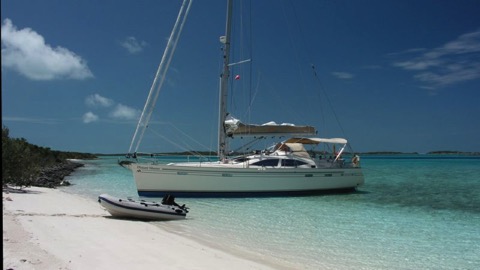
Keeping in Touch - Internet Access
Internet is obviously the most important factor in staying in touch. Over the last year we have been in range of high speed internet for almost all our cruising. So anyone sending us emails need have waited no more than a day of two for a response (if it was urgent!). We do not use any form of satellite or HF radio as I think these are too slow. We use data access through the phone networks, getting a local data plan in each country. Here in Ireland I got a pay-as-you-go data plan for my iPhone 4 as soon as we arrived. We pay 10Euro for 2GB of data over one week. The SIM was just 10Euro as well. Not all countries are as accommodating however so it pays to check where you plan to cruise. Denmark would not let us have a data sim for some reason. The iPhone has been brilliant. Using "data tethering" I have set it up to provide data access to our two laptops. This means both our computers are on the internet all the time for just 10Euro per week here.
In the event that you can’t get data through the mobile phone then you will be using wifi. This is ok as well but less convenient since you generally need to get a new access at each port. This can be a reasonable deal if you stay put in one marina for a while as they often charge a sensible price per week/month. Daily access can be quite costly. Gone are the days of picking up someone’s unlocked wifi. We haven’t seen a free unlocked wifi for some months. And if you do find one you might wonder about wonder about the security risk. Stick with legitimate wifi or a 3G data plan through a mobile phone network.
Keeping in Touch - Phone
4 words... pay-as-you-go. Assuming you travel on a boat sailing (or powering) from country to country at leisurely pace you will be in a country long enough to set up a local phone access by getting a local SIM card. To do this you need an "unlocked phone" otherwise it will not accept different SIM cards. With your new local number you will have free incoming calls and reasonable calls both locally and to countries around the world. Your definition of reasonable may vary - but as we come from Canada with notoriously high phone rates everything looks reasonable to me! If you need to make very long calls there are usually deals to be had for particular countries.
The one problem of getting a new local SIM at each country is the fact that people might not know which number to call you on. There a number of solutions for this depending on our needs. Skype offers an incoming number which I know numerous people have made use of. This year we just kept our UK mobile number active - roaming as we visit other countries. Then when we receive a long call we just ask if we can call back using our local number.
Getting mail/courier
Sending parcels and post out is obviously no problem. But receiving is a bit trickier as we keep on the move. We generally wait until we are certain we are going to be visiting a specific marina - then call them and ask if we can have them receive mail or a package. People at home are generally thrilled to receive a package or mail with foreign stamps. So unless you are trying to pretend you are still sitting in an office tower, the occasional difficulty of forwarding a package will not likely be an issue.
Flying back to do business
If your business requires trips home or to clients that has also got easier in our experience. We book flights online and often return for a few weeks up to few months - leaving the boat in a marina or hauled out. Many marinas around the world are set up to handle people hauling out or leaving the boat temporarily. Check with other cruisers in your intended area. Seven Seas news letters have also been a good source of info for places to lay-up the boat.
Business Office Afloat
Nowadays there are so many improvements to electronics and computers it is easy to keep an office afloat. We have made a few improvements in the boat - and in our business procedures. A bigger battery bank means we can sit at anchor and run computers on a rainy day. We have a small built-in diesel generator (Mastervolt whisper 3.5). A small printer can connect by wifi to both our computers. And because we are on a boat we are extra careful to backup our computers and data! Backup disks are small and cheap these days.
So there you are - sailing with your business. Nowadays there are many business people who might be able to move their office on board. And get out cruising before retirement.

Keeping in Touch - Internet Access
Internet is obviously the most important factor in staying in touch. Over the last year we have been in range of high speed internet for almost all our cruising. So anyone sending us emails need have waited no more than a day of two for a response (if it was urgent!). We do not use any form of satellite or HF radio as I think these are too slow. We use data access through the phone networks, getting a local data plan in each country. Here in Ireland I got a pay-as-you-go data plan for my iPhone 4 as soon as we arrived. We pay 10Euro for 2GB of data over one week. The SIM was just 10Euro as well. Not all countries are as accommodating however so it pays to check where you plan to cruise. Denmark would not let us have a data sim for some reason. The iPhone has been brilliant. Using "data tethering" I have set it up to provide data access to our two laptops. This means both our computers are on the internet all the time for just 10Euro per week here.
In the event that you can’t get data through the mobile phone then you will be using wifi. This is ok as well but less convenient since you generally need to get a new access at each port. This can be a reasonable deal if you stay put in one marina for a while as they often charge a sensible price per week/month. Daily access can be quite costly. Gone are the days of picking up someone’s unlocked wifi. We haven’t seen a free unlocked wifi for some months. And if you do find one you might wonder about wonder about the security risk. Stick with legitimate wifi or a 3G data plan through a mobile phone network.
Keeping in Touch - Phone
4 words... pay-as-you-go. Assuming you travel on a boat sailing (or powering) from country to country at leisurely pace you will be in a country long enough to set up a local phone access by getting a local SIM card. To do this you need an "unlocked phone" otherwise it will not accept different SIM cards. With your new local number you will have free incoming calls and reasonable calls both locally and to countries around the world. Your definition of reasonable may vary - but as we come from Canada with notoriously high phone rates everything looks reasonable to me! If you need to make very long calls there are usually deals to be had for particular countries.
The one problem of getting a new local SIM at each country is the fact that people might not know which number to call you on. There a number of solutions for this depending on our needs. Skype offers an incoming number which I know numerous people have made use of. This year we just kept our UK mobile number active - roaming as we visit other countries. Then when we receive a long call we just ask if we can call back using our local number.
Getting mail/courier
Sending parcels and post out is obviously no problem. But receiving is a bit trickier as we keep on the move. We generally wait until we are certain we are going to be visiting a specific marina - then call them and ask if we can have them receive mail or a package. People at home are generally thrilled to receive a package or mail with foreign stamps. So unless you are trying to pretend you are still sitting in an office tower, the occasional difficulty of forwarding a package will not likely be an issue.
Flying back to do business
If your business requires trips home or to clients that has also got easier in our experience. We book flights online and often return for a few weeks up to few months - leaving the boat in a marina or hauled out. Many marinas around the world are set up to handle people hauling out or leaving the boat temporarily. Check with other cruisers in your intended area. Seven Seas news letters have also been a good source of info for places to lay-up the boat.
Business Office Afloat
Nowadays there are so many improvements to electronics and computers it is easy to keep an office afloat. We have made a few improvements in the boat - and in our business procedures. A bigger battery bank means we can sit at anchor and run computers on a rainy day. We have a small built-in diesel generator (Mastervolt whisper 3.5). A small printer can connect by wifi to both our computers. And because we are on a boat we are extra careful to backup our computers and data! Backup disks are small and cheap these days.
So there you are - sailing with your business. Nowadays there are many business people who might be able to move their office on board. And get out cruising before retirement.
Waterline Waterline!
08/05/11 03:55
We have just completed the first leg of our journey this year - starting in Chichester and sailing down to Falmouth. It was a good example of connecting the dots.... making a quick passage with the aid of a long waterline!
We did three hops - a short 25 mile jump on Wednesday afternoon through the Solent to Lymington. Since it was the first sail of the season we wanted to take it easy and check things over. I had forgotten to rig the tack end of the reef points but otherwise we were fine. It was also the first time we set our new carbon downwind pole. That was a great success as we had a tail wind most of the way. We flew past the other yachts out there who were trying to jibe downwind.
The waterline length of a boat defines the wavelength she creates when moving through the water, and a for most sailboats that defines her maximum speed. We have been impressed by how easily this boat moves through the water as she has a sleek profile and seems to be easily driven. But still she will be held to a theoretical maximum by the length of her waterline. As all yacht designers know this, they will usually try to have the longest waterline for the hull they are drawing. (The only exception is for some racing boats where the racing rule penalizes long waterlines. In this case the people who made the rule agree longer is better - but the designers are trying tricks to get around the rule.)
Leaving the Solent at the Needles
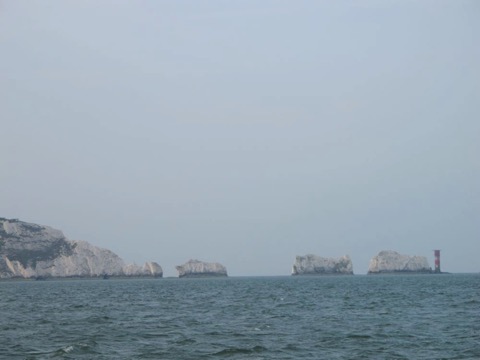
Thursday we had a broad reach from Lymington on to Dartmouth. Again we passed other boats out there averaging 7 knots with apparent of only 10-11 aft of the beam. Here we had another example of the advantage of a long waterline as there was a a mix of seas and 2-meter swell almost on the bow. In any given circumstance, a longer waterline will usually result in a smoother ride. In this case we could hold our speed and course more easily as our sails stayed full and drawing in the rougher patches. Passing other smaller boats (32-40 feet LOA) we had a smoother ride and seemed to keep our speed when they might roll too much and have their sails collapse.
Connecting the dots
The passage to Dartmouth from Lymington was 92 miles. We got under way at 6 and got in before 7. This allowed us to get going after dawn and get in before dark. In our days sailing Two-Step we would never dream of a 90 mile run like that. Planning 5.5-6 knots connects your destinations much differently than at 7-7.5 knots.
Here are a few pix of Dartmouth - a very pretty port town.
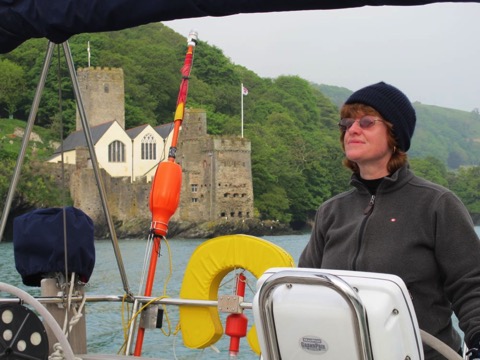
The entrance to the harbour at Dartmouth
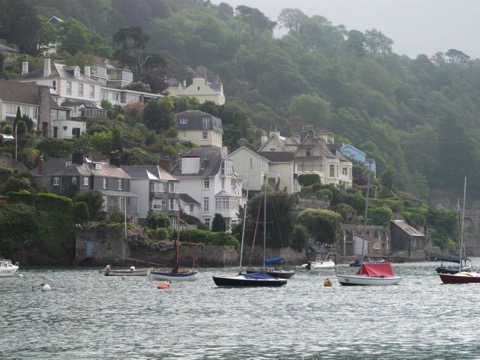
Mooring field in the river Dart


We did three hops - a short 25 mile jump on Wednesday afternoon through the Solent to Lymington. Since it was the first sail of the season we wanted to take it easy and check things over. I had forgotten to rig the tack end of the reef points but otherwise we were fine. It was also the first time we set our new carbon downwind pole. That was a great success as we had a tail wind most of the way. We flew past the other yachts out there who were trying to jibe downwind.
The waterline length of a boat defines the wavelength she creates when moving through the water, and a for most sailboats that defines her maximum speed. We have been impressed by how easily this boat moves through the water as she has a sleek profile and seems to be easily driven. But still she will be held to a theoretical maximum by the length of her waterline. As all yacht designers know this, they will usually try to have the longest waterline for the hull they are drawing. (The only exception is for some racing boats where the racing rule penalizes long waterlines. In this case the people who made the rule agree longer is better - but the designers are trying tricks to get around the rule.)
Leaving the Solent at the Needles

Thursday we had a broad reach from Lymington on to Dartmouth. Again we passed other boats out there averaging 7 knots with apparent of only 10-11 aft of the beam. Here we had another example of the advantage of a long waterline as there was a a mix of seas and 2-meter swell almost on the bow. In any given circumstance, a longer waterline will usually result in a smoother ride. In this case we could hold our speed and course more easily as our sails stayed full and drawing in the rougher patches. Passing other smaller boats (32-40 feet LOA) we had a smoother ride and seemed to keep our speed when they might roll too much and have their sails collapse.
Connecting the dots
The passage to Dartmouth from Lymington was 92 miles. We got under way at 6 and got in before 7. This allowed us to get going after dawn and get in before dark. In our days sailing Two-Step we would never dream of a 90 mile run like that. Planning 5.5-6 knots connects your destinations much differently than at 7-7.5 knots.
Here are a few pix of Dartmouth - a very pretty port town.

The entrance to the harbour at Dartmouth

Mooring field in the river Dart


Changing the prop on the beach
30/04/11 04:30 Filed in: Propulsion | Shallow draft
We put the boat up on the beach yesterday to change the prop.
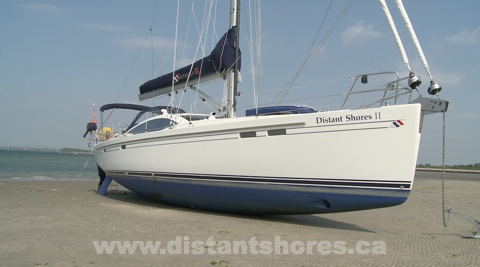
Its been gorgeous weather since we arrived here last week. Its now neap tides so the total tide is just 2.2 meters. Our boat draws 0.9 meters with the keel up. This means we have to get on the beach near high tide so we will have a few hours after the water has fallen by the 1 meter we need to dry out.

We dropped our Fortress anchor as we came in so we would be able to pull back off after, and nosed up on the sand.
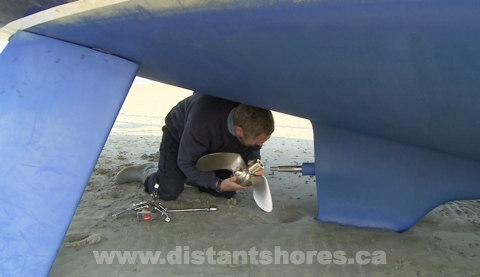
You can see the sand is quite hard - our skeg has just sunk in to the sand by about 4 inches.
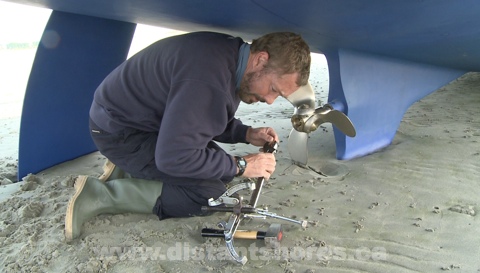
New prop in place! Its an Autoprop and we’ll see how she performs over the season’s cruise.

The Autoprop is made by Bruntons in the UK. It is unique amongst propellors in that its blades find their own proper pitch depending on the situation. I am still a little fizzy on the actual science of this, but I understand the blade is offset from the hub (as you see above) and this allows it to rotate to accommodate the speed of water flowing past. If you are going slower (punching into a head sea or strong wind) then the pitch will be finer. If you are moving faster such as motor sailing - then the blades will take a much coarser pitch to match that.

Its been gorgeous weather since we arrived here last week. Its now neap tides so the total tide is just 2.2 meters. Our boat draws 0.9 meters with the keel up. This means we have to get on the beach near high tide so we will have a few hours after the water has fallen by the 1 meter we need to dry out.

We dropped our Fortress anchor as we came in so we would be able to pull back off after, and nosed up on the sand.

You can see the sand is quite hard - our skeg has just sunk in to the sand by about 4 inches.

New prop in place! Its an Autoprop and we’ll see how she performs over the season’s cruise.

The Autoprop is made by Bruntons in the UK. It is unique amongst propellors in that its blades find their own proper pitch depending on the situation. I am still a little fizzy on the actual science of this, but I understand the blade is offset from the hub (as you see above) and this allows it to rotate to accommodate the speed of water flowing past. If you are going slower (punching into a head sea or strong wind) then the pitch will be finer. If you are moving faster such as motor sailing - then the blades will take a much coarser pitch to match that.
On board preparations!
24/04/11 03:12 Filed in: Propulsion | Rigging
We’re back on board in Itchenor (South of England) getting ready for this year’s cruise. Weather is lovely - like summer actually as its 24 degrees and sunny, flowers blooming etc. Its even a holiday weekend!
Not much maintenance to do - just checking over systems ...
but I do have some NEW PROJECTS that didn’t get sorted last year
Carbon Downwind Pole - Lovely! - beautifully tapered at each end. Carbon might seem like a big expense on a downwind pole but the value is not so much performance as just being able to handle it. This pole is quite a bit lighter than our aluminum pole from our 37 footer Two-Step. So its much longer and stronger but lighter to lift and handle when setting it. I like to store the pole vertically on the mast so we have added a mast track and car to store it. To store on the mast the pole has a socket arrangement to connect it to the mast car. This allows for articulation without jamming when you set the pole (as opposed to a hook/piston going over a ring on the mast)
New Propellor - we sailed last year with a standard 3 bladed fixed propellor and really felt the drag. It is like towing a 20 inch diameter bucket around. We have a shiny new Autoprop this year and are anxious to test it out. Here David of Bruntons (who make the Autoprop) shows me how the bladed rotate to automatically find the correct pitch.
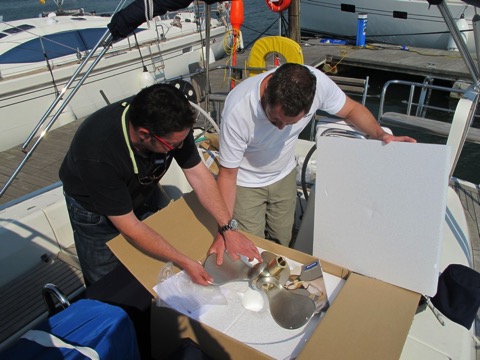
Not much maintenance to do - just checking over systems ...
but I do have some NEW PROJECTS that didn’t get sorted last year
Carbon Downwind Pole - Lovely! - beautifully tapered at each end. Carbon might seem like a big expense on a downwind pole but the value is not so much performance as just being able to handle it. This pole is quite a bit lighter than our aluminum pole from our 37 footer Two-Step. So its much longer and stronger but lighter to lift and handle when setting it. I like to store the pole vertically on the mast so we have added a mast track and car to store it. To store on the mast the pole has a socket arrangement to connect it to the mast car. This allows for articulation without jamming when you set the pole (as opposed to a hook/piston going over a ring on the mast)
New Propellor - we sailed last year with a standard 3 bladed fixed propellor and really felt the drag. It is like towing a 20 inch diameter bucket around. We have a shiny new Autoprop this year and are anxious to test it out. Here David of Bruntons (who make the Autoprop) shows me how the bladed rotate to automatically find the correct pitch.

Boat washes up on the beach
25/03/11 08:57 Filed in: Storms
What do you do if your boat washes up on the beach? Storm winds come up from the wrong direction and your anchorage becomes a lee shore. Then your anchor lets go and your boat is washed up on the beach!!!
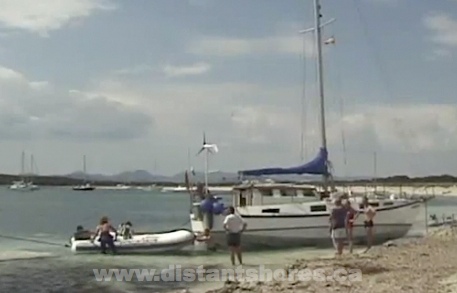
This happened in an anchorage in the Balearic Islands a few years ago - thankfully not to us. We had been keeping a close eye on the weather and had left the anchorage before the storms approach. When we came back to the anchorage there was a boat up on the beach where the storm had thrown her. She drew more than 5 feet and you could walk all around her without getting your knees wet! She was well up the beach and after trying a number of ideas it was impossible to pull her back to sea.
Winching, pulling, a line to the masthead to lean her? No Way! She was well and truly planted as the sand had reformed around her keels (she had twin bilge keels) and she was sitting in perhaps 6 inches of water with her keels down three feet in the sand.
It turned out the solution was to use a couple of small outboard engines?!? Starting by digging a small hole in the ankle deep water - the small dinghy outboard could be run as a fan blowing sand out to make a wading pool than a larger and larger pool. After a couple of hours there is room to move in a more powerful outboard.
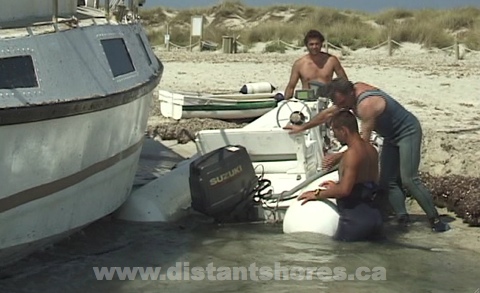
More and more water flowed back into the pools until finally the yacht was nearly floating in her own swimming pool. Incredible that a small engine could move what must have been 100 tons of sand. It did require a bit of TLC afterwards!!
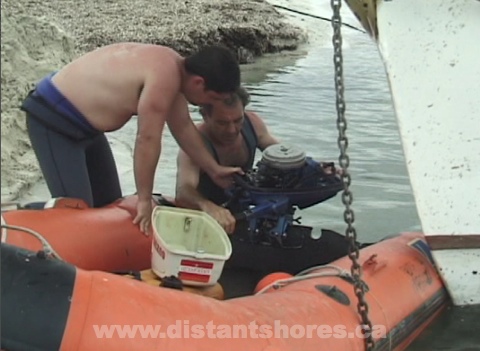
We filmed this exercise and it is included in the first season of Distant Shores on DVD the episode is also available for digital download here on Vimeo.

This happened in an anchorage in the Balearic Islands a few years ago - thankfully not to us. We had been keeping a close eye on the weather and had left the anchorage before the storms approach. When we came back to the anchorage there was a boat up on the beach where the storm had thrown her. She drew more than 5 feet and you could walk all around her without getting your knees wet! She was well up the beach and after trying a number of ideas it was impossible to pull her back to sea.
Winching, pulling, a line to the masthead to lean her? No Way! She was well and truly planted as the sand had reformed around her keels (she had twin bilge keels) and she was sitting in perhaps 6 inches of water with her keels down three feet in the sand.
It turned out the solution was to use a couple of small outboard engines?!? Starting by digging a small hole in the ankle deep water - the small dinghy outboard could be run as a fan blowing sand out to make a wading pool than a larger and larger pool. After a couple of hours there is room to move in a more powerful outboard.

More and more water flowed back into the pools until finally the yacht was nearly floating in her own swimming pool. Incredible that a small engine could move what must have been 100 tons of sand. It did require a bit of TLC afterwards!!

We filmed this exercise and it is included in the first season of Distant Shores on DVD the episode is also available for digital download here on Vimeo.
Internet Access by Phone Data Plan
11/02/11 07:44 Filed in: Communications
These days we find ourselves ever more dependant on the internet - and going into withdrawal when we can’t get connected. WiFi has been quite useful the last 6-7 years but is still limited in range; usually in marinas or popular anchorages. But for wider access the only real options have been satellite ($$$$) or mobile phone data plans.
We have been using mobile data plans for a few years now and it is definitely our preferred way to be on the net. Here is a quick summary of how we got on line the last couple of years.
USA - we used T-Mobile and had good data access all along our trip in 2007-2008-2009. It was $40 per month for 5GB I think. Excellent!!! Since the typical cruise in the USA is for at least a few months it makes sense to sign up for something like this.
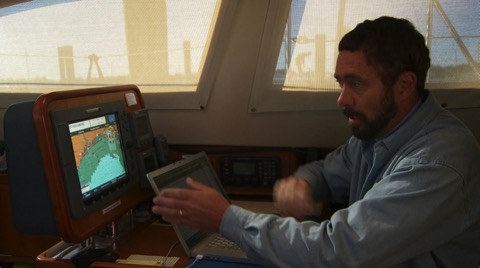
Caribbean - difficult. Since we were in different islands for just a few days or a few weeks it wasn’t practical to do mobile data.
Bahamas - no data plan available when we were last there. Pity. I think Blackberry users are in luck though.
UK - 3-Three - very good data plan - 5GB data for a good price. We used this with a stick, and also tested it with a "mifi" unit to share the data between our 3 units (2 laptops plus iPod/iPad)
Netherlands - OK - We got a stick here too. (but see MiFi below - it would have meant just buying a data sim instead of a new stick) It was not very good value MB per Euro. But I think this is always improving and changing. We were in touch everywhere in Holland during both cruises there in 2010. So that was good - just pricier than we had become used too.
Denmark - NO - they wouldn’t let us have a data access without having a bank account in Denmark. Hopefully this will change.
Sweden - YES - Comviq - excellent data plan - 5GB data for reasonable rates. We were online in even remotest locations during our whole cruise.
Summary. We will continue to use data plans to get online whenever we can. No more worries about wifi access. Also no worries about wifi security (see discussions on firesheep at Panbo). More and more countries have this available and this is good news for sailors!
Mifi - We were introduced to this excellent gadget by a Dutch sailor. It allows you to share a data connection so you only need one data sim when you come to a new country and all your data devices can connect. Its about the size of a deck of cards. We sat it in the middle of the boat and got online from both laptops wherever they were in the saloon.
Cruising with the Internet has never been better and easier!!!! We were even online out here! It was good to be able to check the weather!
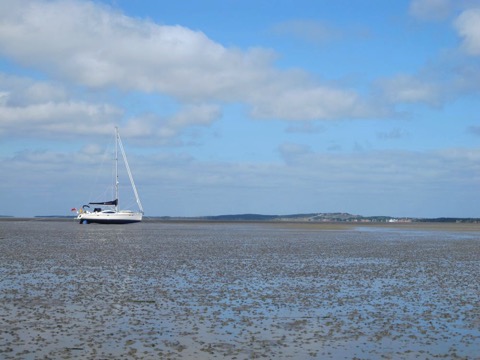
We have been using mobile data plans for a few years now and it is definitely our preferred way to be on the net. Here is a quick summary of how we got on line the last couple of years.
USA - we used T-Mobile and had good data access all along our trip in 2007-2008-2009. It was $40 per month for 5GB I think. Excellent!!! Since the typical cruise in the USA is for at least a few months it makes sense to sign up for something like this.

Caribbean - difficult. Since we were in different islands for just a few days or a few weeks it wasn’t practical to do mobile data.
Bahamas - no data plan available when we were last there. Pity. I think Blackberry users are in luck though.
UK - 3-Three - very good data plan - 5GB data for a good price. We used this with a stick, and also tested it with a "mifi" unit to share the data between our 3 units (2 laptops plus iPod/iPad)
Netherlands - OK - We got a stick here too. (but see MiFi below - it would have meant just buying a data sim instead of a new stick) It was not very good value MB per Euro. But I think this is always improving and changing. We were in touch everywhere in Holland during both cruises there in 2010. So that was good - just pricier than we had become used too.
Denmark - NO - they wouldn’t let us have a data access without having a bank account in Denmark. Hopefully this will change.
Sweden - YES - Comviq - excellent data plan - 5GB data for reasonable rates. We were online in even remotest locations during our whole cruise.
Summary. We will continue to use data plans to get online whenever we can. No more worries about wifi access. Also no worries about wifi security (see discussions on firesheep at Panbo). More and more countries have this available and this is good news for sailors!
Mifi - We were introduced to this excellent gadget by a Dutch sailor. It allows you to share a data connection so you only need one data sim when you come to a new country and all your data devices can connect. Its about the size of a deck of cards. We sat it in the middle of the boat and got online from both laptops wherever they were in the saloon.
Cruising with the Internet has never been better and easier!!!! We were even online out here! It was good to be able to check the weather!

Navigating - Raymarine, iPod & iPad
10/02/11 07:29 Filed in: Navigation | Electronics
Navigating safely has been getting better and easier. Recently we got an iPad with GPS and Navionics charts and I’m looking forward to trying it out on the upcoming cruise.
Last year’s cruise with the new boat we had two new instruments to make navigation easier. The Raymarine E90Wide plotters were great! We have one right at the helm in a pod, and the other up under the dodger (sprayhood) as we use that position at sea. These plotters are a hybrid using touch screen but also have buttons. I loved the buttons and used them most of the time but on rainiest days sometimes switched to the buttons. Often we found ourselves using both. Buttons are convenient for zooming, and then dragging the screen to a new position. Nice!

The plotter at the helm is often right in the sun and this highlights one of the biggest advantages in my mind about a proper marine MFD (multifunction display). The E90W is completely readable in even bright sun. Try that with your laptop! It is also dimmable right down to almost nothing for use at night. It won’t ruin your night vision but you can still see the screen. It it completely waterproof and ready for tough marine conditions like a rough day on the Kattegat as seen here...
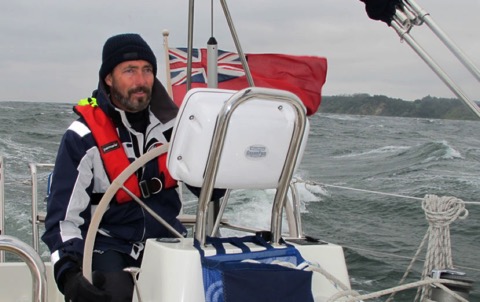
As a fun test I got the Navionics App for my iPod last spring. So we have had a full season cruising and have got to recommend them! We got the Apps for UK/Holland and found it a great tool. It has the tides as well as the full charts for the area and I often found myself using the App to plan our departure times and course - especially in the trickier tides of the Channel Islands. The screen is too small for use with serious navigating but it still had one interesting use. Because it is so small and I always carry my iPod around, I often found myself using the charts when comparing notes with other cruisers. We might be meeting up on someones boat and discussing upcoming destinations. I could pull out my iPod and put on a recommended waypoint or anchorage. Very cool!!
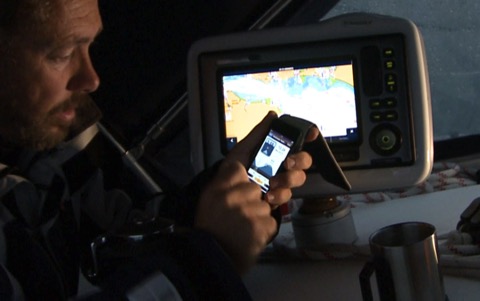
Now we have an iPad I have added the Apps for it too (available in HD for the bigger screen). It will be fun to try this out on the next cruise! I am certain it will it will be a useful addition to our navigation equipment.
Last year’s cruise with the new boat we had two new instruments to make navigation easier. The Raymarine E90Wide plotters were great! We have one right at the helm in a pod, and the other up under the dodger (sprayhood) as we use that position at sea. These plotters are a hybrid using touch screen but also have buttons. I loved the buttons and used them most of the time but on rainiest days sometimes switched to the buttons. Often we found ourselves using both. Buttons are convenient for zooming, and then dragging the screen to a new position. Nice!

The plotter at the helm is often right in the sun and this highlights one of the biggest advantages in my mind about a proper marine MFD (multifunction display). The E90W is completely readable in even bright sun. Try that with your laptop! It is also dimmable right down to almost nothing for use at night. It won’t ruin your night vision but you can still see the screen. It it completely waterproof and ready for tough marine conditions like a rough day on the Kattegat as seen here...

As a fun test I got the Navionics App for my iPod last spring. So we have had a full season cruising and have got to recommend them! We got the Apps for UK/Holland and found it a great tool. It has the tides as well as the full charts for the area and I often found myself using the App to plan our departure times and course - especially in the trickier tides of the Channel Islands. The screen is too small for use with serious navigating but it still had one interesting use. Because it is so small and I always carry my iPod around, I often found myself using the charts when comparing notes with other cruisers. We might be meeting up on someones boat and discussing upcoming destinations. I could pull out my iPod and put on a recommended waypoint or anchorage. Very cool!!

Now we have an iPad I have added the Apps for it too (available in HD for the bigger screen). It will be fun to try this out on the next cruise! I am certain it will it will be a useful addition to our navigation equipment.